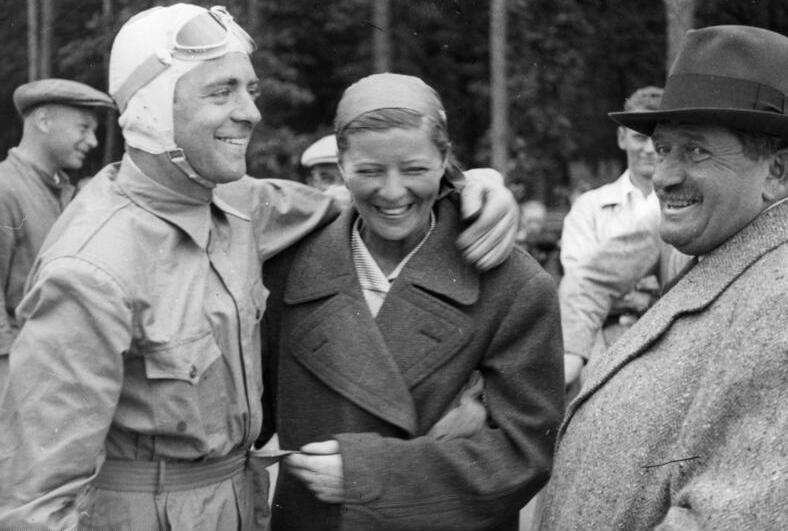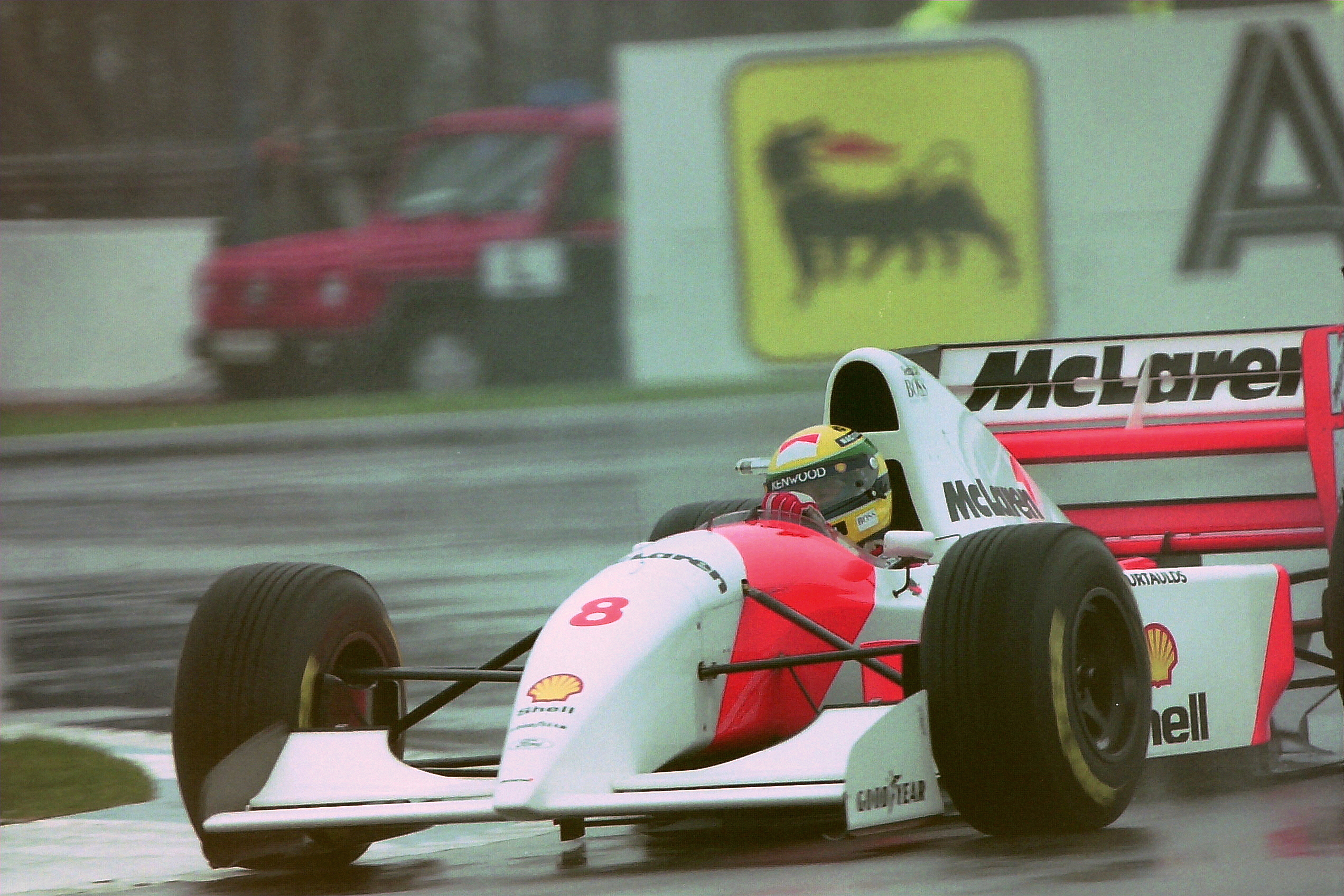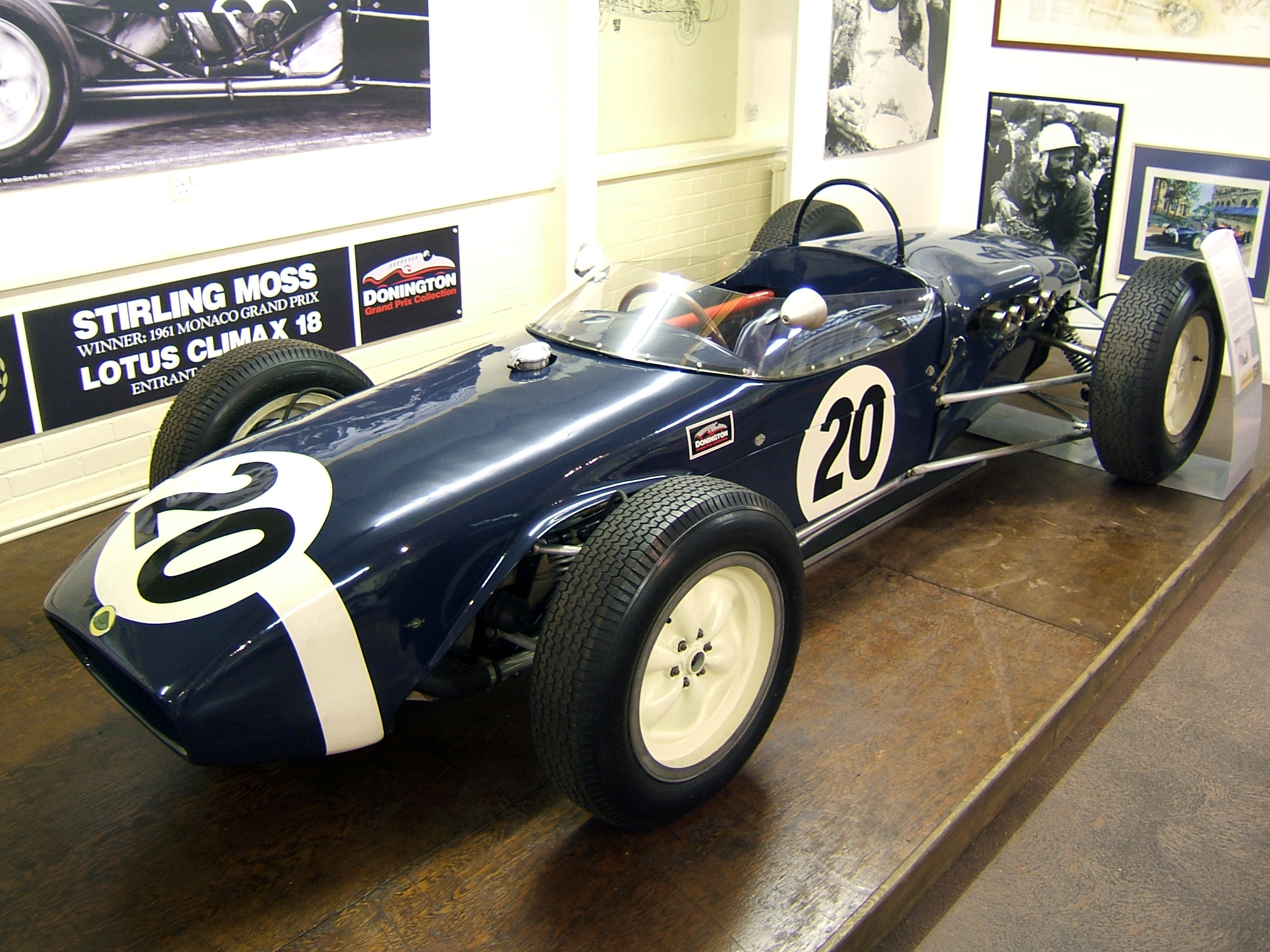|
Donington Grand Prix
The Donington Grand Prix was a Grand Prix motor race held at the Donington Park circuit in Leicestershire, England, from 1935 to 1938. The Donington Grand Prix was held just four times, but quickly rose to prominence as one of the most important races in Europe. A fifth race was planned for 1939 but was cancelled due to the start of World War II. Winners History The first edition of the Donington Grand Prix took place on 5 October 1935. Circuit renovations were undertaken in preparation for the event, these included improving the spectator lot, installing loud speakers, and erecting new bridges at Coppice-lane, Redgate Corner and the Starkey Hairpin. The 1939 edition of the race was originally scheduled for 30 September, with Mercedes-Benz and Auto Union cars scheduled to enter, but was cancelled on 8 September due to World War II. The circuit was closed in 1939 due to the war, when it was requisitioned by the Ministry of Defence and was converted into a military vehicle d ... [...More Info...] [...Related Items...] OR: [Wikipedia] [Google] [Baidu] |
Alfa Romeo
Alfa Romeo Automobiles S.p.A. () is an Italian luxury car manufacturer and a subsidiary of Stellantis. The company was founded on 24 June 1910, in Milan, Italy. "Alfa" is an acronym of its founding name, "Anonima Lombarda Fabbrica Automobili." "Anonima" means "anonymous", which was a legal form of company at the time ( Società anonima). In the initial set-up phase, in order to have a building to produce cars, the company bought the Portello factory building of Darracq in Milan, which was closing up and selling all its assets. The brand is known for sport-oriented vehicles and has been involved in car racing since 1911. Alfa Romeo was owned by Fiat Chrysler Automobiles, the company that was responsible for the production of Alfa Romeo cars until its operations were fully merged with those of the PSA Group to form Stellantis on 16 January 2021. The first car produced by the company was the 1910 24 HP, designed by Giuseppe Merosi. A.L.F.A. ventured into motor racing, with driv ... [...More Info...] [...Related Items...] OR: [Wikipedia] [Google] [Baidu] |
1936 Grand Prix Season
The 1936 Grand Prix season was the third year of the 750 kg Formula. The next iteration of the Mercedes-Benz did not prove successful and the team withdrew during the season to instead prepare for the next one. It therefore fell to the resurgent Auto Union team to dominate the racing. In particular, it was their young, new superstar, Bernd Rosemeyer, who mastered the tricky car and who showed superlative skill in wet conditions. Rosemeyer easily won this season's European Championship by winning three of the four Grands Prix. Once again, it was the old master, Tazio Nuvolari, driving the new Alfa Romeo for the Scuderia Ferrari who proved the greatest challenger to the all-conquering German cars. Without competitive cars, and not wanting to suffer further humiliation from the German teams, the French racing authorities instead ran their major races to their own new sports car regulations. With tensions in Europe rising, politics was increasingly playing a major part in motor- ... [...More Info...] [...Related Items...] OR: [Wikipedia] [Google] [Baidu] |
British Grand Prix
The British Grand Prix is a Grand Prix motor race organised in the United Kingdom by the Royal Automobile Club. First held in 1926, the British Grand Prix has been held annually since 1948 and has been a round of the FIA Formula One World Championship every year since 1950. In 1952, following the transfer of the lease of the Silverstone Circuit to the British Racing Drivers' Club, the RAC delegated the organisation of the race to the BRDC for the first time, and this arrangement has continued for all British Grands Prix held at Silverstone since then (organisation of British Grands Prix held at Aintree having meanwhile been similarly delegated to the British Automobile Racing Club). The British Grand Prix is currently held at the Silverstone Circuit near the village of Silverstone in Northamptonshire in England. The 2019 event was the 70th time that the race had been run as a World Championship event since the inaugural season in , and the 53rd time that a World Champio ... [...More Info...] [...Related Items...] OR: [Wikipedia] [Google] [Baidu] |
1993 European Grand Prix
The 1993 European Grand Prix (formally the Sega European Grand Prix) was a Formula One motor race held on 11 April 1993 at Donington Park. It was the third race of the 1993 FIA Formula One World Championship. The race was contested over 76 laps and was won by Ayrton Senna for the McLaren team, ahead of second-placed Damon Hill and third-placed Alain Prost, both driving for the Williams team. Senna's drive to victory is regarded as one of his finest, and his first lap exploits are particularly lauded, in which he passed four drivers – Michael Schumacher, Karl Wendlinger, Damon Hill and Alain Prost – to take the lead in a single lap in damp conditions. The race was the first held under the European Grand Prix title since 1985, and to date is the only Formula One Grand Prix to have been held at the Donington Park circuit. Report Background After plans to hold an Asian Grand Prix at the Nippon Autopolis in Japan failed to materialise, the first European Grand Prix for eight ye ... [...More Info...] [...Related Items...] OR: [Wikipedia] [Google] [Baidu] |
Donington Grand Prix Collection
The Donington Grand Prix Collection, sometime known as the ''Donington Grand Prix Exhibition'', was a museum of motor racing cars, based at the Donington Park motor racing circuit in Leicestershire, England. The collection, which started in the 1960s, began to deplete in the 2000s. The museum closed permanently on and its large collection was either sold or loaned cars returned to their owners. Overview With five halls and over 130 exhibits, the Donington Grand Prix Collection comprised the largest exhibition of Grand Prix cars in the world. The collection contained vehicles from many forms of open-wheel, single-seater racing, but was primarily focussed on Grand Prix and Formula One machinery. The museum was formed by the late Tom Wheatcroft in March 1973 and is based on Wheatcroft's personal collection of vehicles. These include some that Wheatcroft's own motor racing team ran for drivers such as Roger Williamson and Derek Bell, although many cars exhibited are on loan fr ... [...More Info...] [...Related Items...] OR: [Wikipedia] [Google] [Baidu] |
Ministry Of Defence (United Kingdom)
The Ministry of Defence (MOD or MoD) is the department responsible for implementing the defence policy set by His Majesty's Government, and is the headquarters of the British Armed Forces. The MOD states that its principal objectives are to defend the United Kingdom of Great Britain and Northern Ireland and its interests and to strengthen international peace and stability. The MOD also manages day-to-day running of the armed forces, contingency planning and defence procurement. The expenditure, administration and policy of the MOD are scrutinised by the Defence Select Committee, except for Defence Intelligence which instead falls under the Intelligence and Security Committee of Parliament. History During the 1920s and 1930s, British civil servants and politicians, looking back at the performance of the state during the First World War, concluded that there was a need for greater co-ordination between the three services that made up the armed forces of the United Kingdom: t ... [...More Info...] [...Related Items...] OR: [Wikipedia] [Google] [Baidu] |
Auto Union Racing Cars
The Auto Union Grand Prix racing cars types A to D were developed and built by a specialist racing department of Auto Union's Horch works in Zwickau, Germany, between 1933 and 1939, after the company bought a design by Dr. Ferdinand Porsche in 1933. Of the 4 Auto Union racing cars, the Types A, B and C, used from 1934 to 1937 had supercharged V16 engines, and the final car, the Type D used in 1938 and 1939 (built to new 1938 regulations), had a supercharged 3L V12 that developed almost 550 horsepower. All of the designs were difficult to handle due to extreme power/weight ratios (wheelspin could be induced at over ), and marked oversteer due to uneven weight distribution (all models were tail heavy). The Type D was easier to drive because of its smaller, lower mass engine that was better positioned toward the vehicle's center of mass. Between 1935 and 1937, Auto Unions won 25 races, driven by Ernst von Delius, Tazio Nuvolari, Bernd Rosemeyer, Hans Stuck and Achille Varzi. Aut ... [...More Info...] [...Related Items...] OR: [Wikipedia] [Google] [Baidu] |
British Newspaper Archive
The British Newspaper Archive web site provides access to searchable digitized archives of British and Irish newspapers. It was launched in November 2011. History The British Library Newspapers section was based in Colindale in north London, until 2013, and is now divided between the St Pancras and Boston Spa sites. The library has an almost complete collection of British and Irish newspapers since 1840. This is partly because of the legal deposit legislation of 1869, which required newspapers to supply a copy of each edition of a newspaper to the library. London editions of national daily and Sunday newspapers are complete back to 1801. In total, the collection consists of 660,000 bound volumes and 370,000 reels of microfilm containing tens of millions of newspapers with 52,000 titles on 45 km of shelves. After the closure of Colindale in November 2013, access to the 750 million original printed pages was maintained via an automated and climate-controlled storage facilit ... [...More Info...] [...Related Items...] OR: [Wikipedia] [Google] [Baidu] |
1938 Donington Grand Prix
The 1938 Donington Grand Prix was a Grand Prix motor race held on 22 October 1938 over 80 laps of the Donington Park circuit. The race was won by Tazio Nuvolari driving an Auto Union. The race was organised by the Derby & District Motor Club and not by the Royal Automobile Club, and so is not generally accorded the title "British Grand Prix", notwithstanding that the race was run to the then-current international formula and attracted entries from the top teams, and that there were no other Grand Prix races organised that year in Great Britain. The race was originally scheduled for the 1st of October, with the German Mercedes-Benz and Auto Union teams arriving a few weeks early to prepare, but due to the German invasion of Czechoslovakia, war seemed imminent, so the Germans made to leave, and the French entries seemed unlikely, so the decision was made to cancel the race. With the diplomatic crisis resolved by the Munich Agreement, the race was hastily rescheduled for the 22nd ... [...More Info...] [...Related Items...] OR: [Wikipedia] [Google] [Baidu] |
1938 Grand Prix Season
The 1938 Grand Prix season was the sixth AIACR European Championship season. The championship was won by Rudolf Caracciola, driving for the Mercedes-Benz Mercedes-Benz (), commonly referred to as Mercedes and sometimes as Benz, is a German luxury and commercial vehicle automotive brand established in 1926. Mercedes-Benz AG (a Mercedes-Benz Group subsidiary established in 2019) is headquartere ... team. Caracciola won one of the four events that counted towards the championship. Season review European Championship Grands Prix Non-championship Grands Prix ''Grandes Épreuves are denoted by a yellow background.'' Championship final standings References * * * {{Grand Prix seasons Grand Prix seasons ... [...More Info...] [...Related Items...] OR: [Wikipedia] [Google] [Baidu] |
1937 Donington Grand Prix
The 1937 Donington Grand Prix was a Grand Prix motor race held on 2 October 1937 at the Donington Park circuit. Race report In the race, Hermann Lang led the first few laps but retired with a broken damper, and British driver Richard Seaman followed shortly after. The lead changed hands several times between Manfred von Brauchitsch, Bernd Rosemeyer and Rudolf Caracciola. Whilst in the lead for a second time, von Brauchitsch suffered a puncture, allowing Rosemeyer to pass him and lead the race while his Auto Union teammates could not keep up with the tricky mid-engined car. Rosemeyer stayed in the lead until the end and took the win after 80 laps, with four other German cars completing the full distance within the next minutes before the race was flagged off for good. In ''"When the Germans came to Donington"'', Rodney Walkerley describes the impression the German cars made on British journalists who had not yet witnessed them, being confident in the skills and machinery of Briti ... [...More Info...] [...Related Items...] OR: [Wikipedia] [Google] [Baidu] |
Bernd Rosemeyer
Bernd Rosemeyer (14 October 1909 – 28 January 1938) was a German racing driver and speed record holder. He is considered one of the greatest racing drivers of all time. Though he was not a member of the Nazi party, he was made a member of the Schutzstaffel, SS for propaganda purposes and held the rank of Hauptsturmführer. Career His father owned an auto & moto garage and repair shop ''Rosemeyer & Co sur Bahnhofstraße'', where young Rosemeyer worked on motorcycles and cars. Having started by racing motorbikes, Rosemeyer became a member of the Auto Union racing team with hardly any experience in racing cars. This was later considered a benefit as he was not yet used to the handling of FR layout, traditional layout race cars. The Ferdinand Porsche-designed mid-engined Silver Arrows of Auto Union were fast, but hard to drive, and only he, Tazio Nuvolari and to a lesser extent Hans Stuck truly mastered the machines. Rosemeyer was also a very skilled mechanic, so, like Hermann ... [...More Info...] [...Related Items...] OR: [Wikipedia] [Google] [Baidu] |





_(Tony_Radakin_cropped).jpg)

